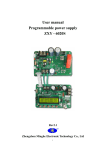Download HP LD4245tm User's Manual
Transcript
HP Video Over Ethernet User Guide © 2012, 2014 Hewlett-Packard Development Company, L.P. The information contained herein is subject to change without notice. The only warranties for HP products and services are set forth in the express warranty statements accompanying such products and services. Nothing herein should be construed as constituting an additional warranty. HP shall not be liable for technical or editorial errors or omissions contained herein. This document contains proprietary information that is protected by copyright. No part of this document may be photocopied, reproduced, or translated to another language without the prior written consent of HewlettPackard Company. Windows®, Windows® XP, and Windows Vista® are either trademarks or registered trademarks of Microsoft Corporation in the United States and/or other countries. Second Edition (January 2014) First Edition (January 2012) Document Part Number: 661964-002 Table of contents 1 Product Overview .......................................................................................................................................... 1 Features ................................................................................................................................................................. 1 2 System Setup ................................................................................................................................................ 2 System Requirements ........................................................................................................................................... 2 Loading Software ................................................................................................................................................... 2 Making Displays Visible to the Software ............................................................................................................... 3 3 Operating VOE ............................................................................................................................................... 4 Entering Display Information ................................................................................................................................ 5 Player Name ........................................................................................................................................ 5 Display Name and Display Location .................................................................................................... 6 Display Model ...................................................................................................................................... 6 User Mode .............................................................................................................................................................. 7 Search .................................................................................................................................................. 7 Associate ............................................................................................................................................. 8 Make an Association One at a Time .................................................................................................... 8 Association and Connection of Multiple Displays ............................................................................. 10 Clear an Association and Connection ................................................................................................ 12 Administrator Mode ............................................................................................................................................. 14 Search ................................................................................................................................................ 15 Associate ........................................................................................................................................... 15 Make an Association .......................................................................................................................... 15 Change an Association ...................................................................................................................... 18 Reset Display ..................................................................................................................................... 19 View Log ............................................................................................................................................ 19 Password ........................................................................................................................................... 20 Display Settings ................................................................................................................................ 25 Update Firmware ............................................................................................................................... 27 Logout ............................................................................................................................................... 29 4 Using ViewSpan ........................................................................................................................................... 30 User Options ........................................................................................................................................................ 30 5 Troubleshooting .......................................................................................................................................... 34 Issues and Solutions ............................................................................................................................................ 34 iii Upgrading VOE ..................................................................................................................................................... 34 Removing HP Video Over Ethernet ...................................................................................................................... 35 iv 1 Product Overview HP Video Over Ethernet (VOE) is a system of software, hardware, and firmware for connecting HP Digital Signage Displays on a network with computers/media players on the same network. A computer or media player running VOE software becomes a candidate video source for displays anywhere on the network and is referred to in this manual as a media player, or just player. The connection between the display and player is called an association. The VOE software manages the associations between players and displays. VOE enables players to be distant from the display and facilitates the central management and control of digital out of home networks, provides the ability to more efficiently and cost effectively implement and deploy digital signage solutions, and helps provide redundancy and backup for players that can mean greater availability of the digital sign. With central location, control, and management of the player in a remote location such as the corporate datacenter, there is less responsibility placed on the remote staff where the digital sign is located for maintenance and operation of the digital sign. VOE software running on the player provides a User Interface (UI) with intuitive menus to guide the user through the discovery, association, and administrative tasks. The VOE discovery feature will search the network and list all the network-attached displays that are available to be associated with the player. If the display has the Player Name populated with an existing player name on the network, an association between that display and named player will be automatically made without user intervention. If the display does not have a player named, it may be associated with any player in the network. Because each display keeps the name of its assigned player in non-volatile memory, interrupted associations between displays and players are re-established without user intervention. Following a network disruption or power failure, displays will automatically be re-associated and connected with their named players on the network and will begin playing images and sound as soon as the network connection and the association between the display and player is re-established. VOE provides the flexibility to change the association between a display and player at the discretion of the user. When a display loses the network connection to its assigned player, it becomes disassociated and other players on the network can detect that it is free. The user may establish an association between the display and another player before the named player comes back on line. Should the player come back on line before the display association can be changed, its association will be automatically restored and the status of the display on the menu list will be Connected so users will see that the display is no longer available. One player at a time can have administrative authority to change associations other than its own. The Administrator is any player where a user has logged in as an Administrator, using the appropriate password. Features The Video Over Ethernet system offers: ● Remote display discovery, association, and connection ● Change association and connection between displays and players ● Ability to associate and connect up to 25 displays using DisplayPort and 12 displays using RGB/VGA with one player ● Automatic association and connection between displays and players if the player name in the display matches the computer name of any player on the network ● Automatic re-association and connection after a network interruption Features 1 2 System Setup System Requirements Any player running a Microsoft Windows XP, Vista, Windows 7, or Windows 8 Operating System can become a VOE media player. Requirements are: RAM 4GB Disk space 12MB Windows Experience Index 4.0 to drive displays with 1366 x 768 native resolution 4.3 to drive displays with 1920 x 1080 native resolution Operating system Windows® XP (32 bit) Windows Vista® (32 or 64 bit) Windows® 7 (32 or 64 bit) Windows 8 CPU Dual-core 2.4Ghz Loading Software The VOE software and firmware package is available on the CD accompanying a digital signage display with VOE capability. It can also be downloaded from http://www.hp.com/support. Install the software on each networked media player to be used as a video source for displays. To download from the Internet: Follow the link above, select the applicable country or region and language, choose Support and Drivers, and then select Product Support and Troubleshooting. Enter the model name of the display. TIP: Before starting installation, owners of Windows 8, Windows 7, and Windows Vista operating systems need to ensure that the display adaptor of the media player is running the latest Windows display driver model (WDDM) driver. The drivers are available from Microsoft. Launch the VOE installer from either the CD or the downloaded installation package. Two programs will be installed: VOE and ViewSpan. Windows may display a warning box or Security dialog during installation. Select the options to allow installation and trust software from both Elite Silicon Technology and SMSC (Smart Mixed-Signal Connectivity). After the programs are installed, VOE starts automatically and will always run as a background process unless the user deliberately stops it. The installation process installs a VOE icon on the desktop. In addition, the user will see two new icons in the system tray as shown in the following figure: 2 Chapter 2 System Setup Figure 2-1 VOE and ViewSpan Icons 1 VOE icon Right-click this icon to open the VOE dialog or Quit to stop VOE 2 ViewSpan icon Right-click icon to bring up Windows display settings dialog or Exit to stop the driver VOE is set up to automatically start any time the player/computer is booted. To change this default setting, right-click on the VOE icon and click on the check mark next to Run this application when PC starts up. When this option is chosen, the user must double-click on the VOE desktop icon to start the VOE application and user interface each time the player/computer is booted. It is recommended to keep the default setting so players and displays will automatically associate and connect when the player/computer is booted. Figure 2-2 VOE Setting Options Making Displays Visible to the Software In order for VOE software to find the displays the user wants to drive, they need to have IP addresses on the user's network. Refer to the display documentation for details on IP addresses. In order to distinguish one display from another, each needs a name and location. These can be any text meaningful to the user. Enter names and locations at the display, using its on-screen menu (refer to the documentation included with the display), or enter them through VOE when signing on as an administrator (see Display Settings on page 25 in this guide for details). Making Displays Visible to the Software 3 3 Operating VOE VOE runs as a background process whenever the player is running. This process monitors the network, detecting connected displays and other players. When the VOE application is started, it opens the user dialog and displays the VOE main menu to allow the user to perform operations. Closing the window does not break connections to displays or prevent the player from showing to other players. If the user has closed the VOE user interface window by clicking on the X, start the user interface again by right-clicking on the VOE dialog and clicking Open VideoOverEthernet. To stop the VOE application from running, right-click on the VOE icon and then click on Quit. The VOE icon disappears from the system tray. When the user stops the application, it breaks any association and connection of displays to the player, and the display status will change to Ready to Connect. To restart the VOE application and user dialog, double-click the VOE desktop icon. All associations and connections are automatically re-established as long as another player in the network has not associated with the display. The VOE main menu is shown in the following figure: Figure 3-1 VOE Main Menu 4 1 Association Box Check box to indicate the display to make an association with the player. In User Mode, clicking on the check box will launch the association process. It will not highlight the display for any other functions. 2 Display Name Will show the display name if it has been created in the display's On-Screen Display (OSD) menu or with the VOE Display Settings dialog 3 IP Address The IP address assigned to the display in the network 4 MAC ID The MAC ID of the display 5 Display Location Will show the Display Location field of the display if it has been created in the display's OSD menu or with the VOE Display Settings Dialog 6 Display Model Displays the model number of the networked display Chapter 3 Operating VOE 7 Player Name Displays the Player Name of the player associated with the display 8 Status Displays the status of the display. Ready to Connect (the display is available to be associated) or Connected (the display is already associated with a player and is not available to be associated with any other player) VOE Main Menu Opening a VOE window shows all the displays detected on the network, each on its own line. Columns on the VOE Main Menu show display information. See Figure 3-1 VOE Main Menu on page 4. A display must be highlighted before the user can perform any operations such as changing its name or location. Highlight a display by clicking any column entry for the display wanted. Modes and Privileges The upper left corner of the VOE menu window indicates the mode and privileges of the operator. VOE opens the user interface in User Mode with no designation in the upper left corner as shown in Figure 3-1 VOE Main Menu on page 4. However, If the user logs on as an Administrator, the upper left corner will indicate Master Administrator if the Master Administrator password has been used, or Administrator if the user entered one of the other three possible administrator passwords. To view these designations, refer to Figure 3-1 VOE Menu Window - Master Administrator, Administrator, User on page 5. For more password information, see Password on page 20. Entering Display Information Each VOE display has variable data populated either by the end user or by the VOE software. Data fields include: ● Player Name ● Display Name ● Display Location ● Display Model The Display Name, Display Location, and Player Name fields can include up to 32 characters or numbers along with any special character except the percent sign (%). Player Name The Player Name field can be entered initially from the display's On-Screen Display (OSD) menu or this field will be entered or changed by the VOE software when an association is made between the display and a player on the network. If the Player Name field is entered from the display's OSD, when VOE is launched and the Player Name in the display matches a player on the network with the same Computer Name, the association will automatically be made without any user intervention. When an association is made, VOE will automatically populate the Player Name field. The Player Name is the Computer Name entered into Windows. In Windows 8, to check or change the computer name, from the Start screen, type c, and then select Control Panel from the list of applications. Choose System, and then locate the computer name under Computer name, domain, and workgroup settings. VOE displays the Computer Name as the Player Name. Entering Display Information 5 In Windows 7, go to the Control Panel, choose System, and then locate the computer name under Computer name, domain, and workgroup settings. VOE displays the Computer Name as the Player Name. Figure 3-2 Locating the Computer Name in Windows 7 In Windows Vista, open the Control Panel, choose System and Security, and then select See the Name of this computer to view or change the name of the player. VOE displays the Computer Name as the Player Name. In Windows XP, open the Control Panel, choose System, and then select Computer Name to see or change the name of the player. The Computer Name that VOE displays is the text starting from the left of the Full Computer Name to the first period delimiter (Example: The full computer name is: TestSys899HP.YourDomain.net - Thus, VOE will display TestSys899-HP as the Player Name). Display Name and Display Location There are two user-defined fields in a VOE display that may help to uniquely identify displays in the network: Display Name and Display Location. The information in these fields may be any text or numbers meaningful to the user, along with any special character except the percent sign (%), and may be up to 32 characters in length. The default text in the Display Name field is Display Name and the Display Location is blank. If these fields are not populated, the Display Name and Display Location in the list will show the default text or blanks. The information may be entered into these fields in two ways: ● First, the information may be entered with the display's On-Screen Display (OSD). For details, refer to the User Guide included with the display. ● The second way to enter information is with VOE. To input the Display Name and Display Location information by using VOE, see Display Settings on page 25 in this guide for details on how to populate these fields. Display Model The Display Model field is automatically populated in the display during the manufacturing process, and VOE lists this information to differentiate between VOE display models within the network. 6 Chapter 3 Operating VOE User Mode VOE manages the association between networked displays and players. There are two modes for managing the associations: User Mode and Administrator Mode. Each mode has a unique main menu that allows different functions depending on the mode. This section addresses User Mode. There is no password authentication required in User Mode. The first time VOE is launched, it opens in User Mode. See Figure 3-3 User Mode Menu on page 7. In User Mode, associations can only be managed between any available display in the network and the player running the VOE user interface. In this mode, the only options are available are: ● Search – Search the network and list all the displays in the network, indicating which displays are available for association ● Associate – Establish an association between an available display and the player running the user interface Major functions include: ● ◦ Make an Association One at a Time ◦ Association and Connection of Multiple Displays ◦ Clear an Association and Connection Administrator – Launch the Administrator Log ON dialog box to enter an administrator password Figure 3-3 User Mode Menu Notice in the User Mode Menu above that Display11 has a check mark in the association box. It has a Player Name, and the status is Connected. Also note that the Player Name has Local Host appended to the name. This indicates that the user is running VOE from this player (TestSYS899-HP). Search When the VOE software is launched, VOE automatically searches the network to find all the attached VOE displays and lists all displays on the menu. VOE automatically refreshes the list by executing a search of the network any time some action is taken such as an association, change display settings, break an association, or change an association. Click the Search button at any time to refresh the list of displays in the menu. User Mode 7 Associate User Mode allows users to associate up to 12 displays with any one player and break or Clear any existing associations of displays to the player. An association may be made either one at a time, or multiple displays may be associated at the same time. In User Mode, any available display (with Ready to Connect status) can be chosen to be associated with the player. Make an Association One at a Time A single association is made as follows: 1. Click on the check box of the available (Ready to Connect) display to be associated with this player. Figure 3-4 Selecting the Display for Association The name of the player appears in the Player Name column, and a check appears in the association box as shown in the following figure. Figure 3-5 Associate the Display with Player 8 Chapter 3 Operating VOE 2. Click on the Associate button to make the association. The confirmation box appears. Figure 3-6 Association and Connection Confirmation 3. Click OK to make the connection. Click on Cancel to abort the association and connection attempt. If the association and connection attempt is successful, the user is returned to the menu. The list is updated with a check mark in the Association box. The Player Name is filled in with the local player name, and the Status is changed to Connected. Figure 3-7 Updated Menu List User Mode 9 Association and Connection of Multiple Displays In User Mode, VOE allows the association and connection of multiple displays at once. In the figure below, the menu list shows two displays available to be associated and connected with the player. Figure 3-8 Menu List with Available Displays 1. Click on the first check box. The Player Name is filled in, and a check appears in the check box. Figure 3-9 Select the First Display for Association 10 Chapter 3 Operating VOE 2. Click on the next display to associate with this player. Both display lines now show the Player Name and checks in the association boxes. Figure 3-10 Multiple Displays Selected for Association and Connection 3. Click on the Associate button. The association and connection confirmation box appears. Figure 3-11 Association and Connection Confirmation Box User Mode 11 4. The confirmation box shows both selected displays are ready to be associated and connected to the same player. Choose OK to keep the association and make the connection. The menu list updates, and the two displays now have a Connected status. Figure 3-12 Multiple Displays Associated and Connected Clear an Association and Connection In User Mode, the user can also break or clear the association and connection for any display associated with the player. To Clear the association: 1. Click on the check box of the display to be cleared of its association and connection. Figure 3-13 Clear an Association and Connection 12 Chapter 3 Operating VOE 2. The Clear Association dialog box appears. Click OK to break the association and connection for the selected display. If applicable, click on Cancel to abort the Clear Association process. Figure 3-14 Clear Association Dialog Box After a successful clear, the menu list updates and shows the display is now available (Ready to Connect). The Player Name field is blank, and the check box is also blank. Figure 3-15 Clear Association Result User Mode 13 Administrator Mode Administrator Mode allows the user to manage associations and connections for all the displays and players on the network. In Administrator Mode, the user can make or break an association on the player the user interface is running on (as in User Mode), or make or break an association between any other display and any other player in the network. Administrator Mode also enables additional tasks to be performed. Enter Administrator Mode from the main User Mode menu by clicking on the Administrator button. The Password Authentication dialog box appears. Figure 3-16 Password Authentication Dialog Enter the password to access the Administrator Menu where a list of all the displays in the network is shown. Figure 3-17 Administrator Menu The Administrator Menu provides the following functions: 14 ● Search – Search the network and list all the displays in the network, indicating which ones are available for association ● Associate – Establish an association with any available display and player running the user interface ● Reset Display – Reboot the VOE system of any selected (highlighted) display in the network ● View Log – View the VOE log of the player running the user interface. Each player has a unique VOE log showing all the VOE commands and actions taken as well as the results. ● Password – Allows the user logged on with the Master Administrator Password to assign, clear, and change passwords ● Display Settings – Allows the administrator to change the Display Name and Display Location information for any display that is not connected to a player Chapter 3 Operating VOE ● Update Firmware – Allows the administrator to update the VOE firmware on any display in the network that is not connected to a player ● Logout – Leave Administrator Mode and return to User Mode Search In Administrator Mode, the search function works the same as in User Mode. For details, see User Mode on page 7 of this document. Associate The association and connection process in Administrator Mode is slightly different from the process in User Mode. In Administrator Mode the user can: ● Make an association and connection between any available display and any player on the network ● Break or Clear an association and connection between any connected display and player on the network ● Change an association between any connected display and player In Administrator Mode, users work with only one display at a time and cannot change multiple display associations simultaneously. Make an Association Make an association and connection as follows: 1. Click on the check box of the available (Ready to Connect) display to be associated with this player. Figure 3-18 Select Display to Associate and Connect Administrator Mode 15 2. The Change Association dialog box appears. Click on the pull-down menu. Figure 3-19 Change Association Dialog Box 3. The pull-down list shows all the players in the network. Select the name of the player to associate the display with this player. Click OK to make the association. Figure 3-20 Select Local Player 16 Chapter 3 Operating VOE 4. The confirmation dialog box appears. Click OK to confirm the association and make the connection. If applicable, click Cancel to abort the association and connection process. Figure 3-21 Association and Connection Confirmation The menu list updates according to choices made. Figure 3-22 Updated Menu List Administrator Mode 17 Change an Association Administrator Mode allows the user to change the association of any display with any player. The process is very similar to making an association with an available display (Ready to Connect) in User Mode, except the user may choose any Connected display on the list. To change an association and connection: 1. Select the display whose association and connection are to be changed by clicking on the association box. Figure 3-23 Select Display to Change Association and Connection 2. The Change Association dialog box appears. Click on the pull-down menu which shows all the players in the network. Select the new player to associate and connect with this display. Click OK to keep the new association and make the new connection between the display and changed player. Figure 3-24 Select the New Player for Association and Connection 18 Chapter 3 Operating VOE 3. The menu list updates and shows the display now Connected to the new player. Figure 3-25 Updated Menu List with New Player Connected Reset Display Reset Display reboots the VOE hardware in any highlighted display selected from the menu. The display must be available (Ready to Connect). In the unlikely event that a display should freeze or seem to hang up, press the Reset Display button to make VOE operational again. View Log Each player has an event log created by VOE. An entry is made for every action taken at that player. Actions include logging in as administrator, making an association, breaking or clearing an association, and executing the display setting dialog. All errors with VOE are also logged. To view the event log for a player, press the View Log button. VOE displays the log in a Windows Notepad window. The VOE log may be saved to a file, edited, formatted or viewed the same as any other text file in Windows Notepad. Figure 3-26 VOE Log File Administrator Mode 19 Password VOE provides a Master Password set to admin by the factory. It is recommended that the password be changed immediately to something unique. The password can be a maximum of 30 characters. VOE allows the creation of up to three additional Administrator passwords. Only the user who is logged on with the Master Password can create, clear, or change these additional passwords. User Mode does not require a password. However, when the user presses the Administrator button on the User Mode menu (to change to Administrator Mode), an Authentication Menu appears requiring the entry of a password. Figure 3-27 Password Authentication Menu To manage passwords in VOE: 1. Log on with the Master Administrator password. Press the Password button on the Administrator Mode menu, and the Password Dialog box appears. Figure 3-28 Password Dialog Box 2. 20 To change the Master Administrator password, click on the Change Password button. Chapter 3 Operating VOE 3. The Change Password dialog box appears. Enter the new password in the Change Password field. Passwords are case sensitive and may be any combination of alphanumeric characters and blanks up to 30 characters. Enter the new password again in the Confirm New Password field to confirm. Click Submit. Figure 3-29 Change Master Administrator Password Dialog If the same password is not entered in the Confirm New Password field to confirm, an error message displays. Figure 3-30 Error Message for Incorrect Password Confirmation 4. To clear the error message, click on OK. Re-enter the correct password in the Confirm New Password field, and click Submit. The Change Password confirmation box appears. Figure 3-31 Change Password Confirmation Box 5. Click OK on the Change Password Confirmation box. Administrator Mode 21 Reset Password Option 1. If the user clicks the Reset Password button on the password dialog box, the Master Administrator password resets to admin. Figure 3-32 Reset Password Confirmation 2. The Reset Password confirmation box appears. Click OK to confirm the reset. Figure 3-33 Reset Password Confirmation Additional Administrator Passwords VOE allows the assignment of three additional Administrator passwords. These additional Administrator passwords grant authority to users to execute all the functions of the Master Administrator password except for Password management. Only the user logged on with the Master Administrator password can access and execute the Password management functions. To set additional Administrator passwords: 22 Chapter 3 Operating VOE 1. Click on the Set button next to the selected Administrator (Administrator 1, Administrator 2, or Administrator 3). Figure 3-34 Set Administrator Password 2. The Change Password dialog box appears. Enter the password for the selected Administrator in the Change Password field, and re-enter it in the Confirm New Password field to confirm. The password can be any combination of alphanumeric characters or blanks up to 30 characters. Click Submit to set the password. Figure 3-35 Change Password Dialog to Set Administrator Password 3. The Change Password confirmation box appears. Click OK to clear the Change Password confirmation box and return to the Password dialog. Figure 3-36 Change Password Dialog Box for Administrator Password Clearing the Additional Administrator Passwords The Master Administrator may clear any of the three additional Administrator passwords. Administrator Mode 23 To clear passwords: 1. Click on the Clear Password button next to the Administrator password to be cleared. Figure 3-37 Clear Administrator Password 2. The Clear Password confirmation box appears. Click OK on the Clear Password confirmation box to return to the Password Dialog box. Figure 3-38 Clear Password Confirmation Box 3. 24 The Password Dialog box appears. To exit, click OK to return to the Administrator Mode menu. Chapter 3 Operating VOE Figure 3-39 Exit Password Dialog Display Settings Each VOE display has two user fields that may be populated to help identify displays and their locations. This can be very helpful in a large network of displays that are centrally managed and controlled. The two fields, Display Name and Display Location, can be set two different ways: with the display OSD or with the VOE's Display Setting Dialog. To populate the Display Name and Display Location fields using VOE: 1. In the Administrator menu list, highlight the desired display by clicking on any of the menu columns (other than the check box). The display must not be connected to any player, but it must have a status of Ready for Connection in the status column. Click on the Display Setting button. Figure 3-40 Highlighting a Display to Enter Display Information Administrator Mode 25 2. A Configuration dialog box appears with Display Name and Display Location fields enabled for data entry. Figure 3-41 Configuration Dialog 3. Enter the Display Name and Display Location information in their respective fields in the Configuration Dialog box. Click Set to save the change to the display memory. When this button is clicked, there may be a slight delay until the confirmation message appears. If applicable, click Cancel to abort the change. Figure 3-42 Enter Display Name and Display Location 26 Chapter 3 Operating VOE 4. The confirmation message appears. Click OK to clear the confirmation message. Figure 3-43 Display Setting Confirmation Message 5. The menu list updates with the new Display Name and Display Location. Figure 3-44 Changed Display Name and Display Location Information 6. If the fields are not changed to the new information after clearing the confirmation message, click Search to refresh the display list in the menu. The new information should appear. Update Firmware HP digital signage displays (that support VOE) have firmware that communicates with the VOE software running on networked players. The VOE firmware can be updated without affecting other operations of the display, although the display must be free (VOE status is Ready to Connect) during the upgrade. The VOE firmware comes with the software and is placed in the VOE program folder (Location: Program Files \HP\Video Over Ethernet), unless the user specified a different location when the VOE software was installed. Firmware updates are made available on the Web site: http://www.hp.com/support. Select applicable country or region and language. From the Support and Drivers page, select Product Support and Troubleshooting. Enter the name of the display model. Start the upgrade process by getting the new firmware. Download the file to the player and write down the name of the directory where the file was saved. Then proceed as follows: Administrator Mode 27 1. Log on as an Administrator. 2. Highlight the display to be upgraded. It must have the status Ready to Connect. 3. Press the Update Firmware button on the Administrator Mode menu. Figure 3-45 Update Firmware 4. VOE opens the Windows dialog to browse for the directory of the firmware binary file that was downloaded by the user. Figure 3-46 Browse for Directory of Firmware Binary File 5. 28 After locating the firmware file, highlight the file and click Open. The process of downloading to the display begins immediately. When this process finishes, a message pops up to indicate the status of the firmware update. After successful update of the display VOE firmware, the VOE hardware is automatically restarted with the new firmware running. Chapter 3 Operating VOE Logout To log off as Administrator (Administrator Mode), click the Logout button to return to the User Mode main menu. Administrator Mode 29 4 Using ViewSpan User Options ViewSpan provides users the ability to manage display settings for VOE displays. ViewSpan is installed with the VOE software and is launched by clicking on the ViewSpan icon in the System Tray. Figure 4-1 ViewSpan Icon When launched, ViewSpan presents the Windows Display Settings dialog screen. Figure 4-2 View Span Display Setting Dialog The Display Settings dialog screen offers the user choices. It shows graphical representation of the displays allowing the user to define the arrangement and appearance of displays. The dialog box also provides pulldown windows enabling the user to make decisions regarding the display, resolution, and multiple displays. The user may choose to: 30 ● Detect and identify displays ● List the displays detected (See Figure 4-3 Display List on page 31.) ● Change the resolution of the displays (Refer to Figure 4-4 Change Display Resolution on page 31.) ● Change orientation of the displays (Landscape or Portrait mode) (See Figure 4-5 Change Display Orientation on page 32.) Chapter 4 Using ViewSpan ● Define how multiple displays show the desktop (Go to Figure 4-6 Multiple Display Definition on page 32.) ● Arrange displays in a single virtual desktop (Refer to Figure 4-7 Arranging Displays in a Logical Desktop on page 33.) Examples of these functions are provided in the following figures: ● List the detected displays Figure 4-3 Display List ● Change resolution of the displays Figure 4-4 Change Display Resolution User Options 31 ● Change orientation of the displays (Landscape or Portrait mode) Figure 4-5 Change Display Orientation ● Define how multiple displays show the desktop Figure 4-6 Multiple Display Definition 32 Chapter 4 Using ViewSpan ● Arranging displays in a single virtual desktop Figure 4-7 Arranging Displays in a Logical Desktop After the appropriate settings have been selected or the arrangement of displays is completed, click Apply to accept the changes, and then click OK to exit the dialog. User Options 33 5 Troubleshooting Issues and Solutions At times VOE issues may occur, and solutions to address those issues are indicated in the Troubleshooting table. Table 5-1 Troubleshooting a VOE Network Problem Possible Solutions VOE Software does not detect a display Make sure the display is powered on and correctly connected to the network. Verify that the Display Name, Display Location, IP Address and other network settings in the display are correct. If there is any personal firewall software installed on the Player, make sure VOE software is on the Exception List/White List of that personal firewall software. VOE Software does not detect a player. Make sure the player is powered-on and properly connected to the network. Verify that the VOE software is installed and running on the player. If there is any personal firewall software installed on the Player, make sure VOE software is on the Exception List/White List of that personal firewall software. Cannot Associate player with selected display. Verify that the display is not associated with another player. No video on an associated display. Ensure that the display is powered on and its input source is set to VOE. Streaming video freezes. Check the network connection to the display for possible interruptions. Video frame rate is low, or video quality is low. Set the VOE display resolution to 1366 x 768 or lower. Verify that the network bandwidth is sufficient to handle the connected displays. Upgrading VOE All versions of VOE software and firmware are compatible with each other. Thus, players and displays on the same network can run different versions. Upgrading software is a simple matter of repeating the installation process described in Loading Software on page 2. Upgrading firmware is only slightly more complex. HP digital signage displays run two firmware programs: ● VOE assignments ● All other operations To view the procedure, refer to Update Firmware on page 27. 34 Chapter 5 Troubleshooting Removing HP Video Over Ethernet To remove VOE software from a player or media player, use the Windows operating system Control Panel. Select Programs and Features, and then highlight Video Over Ethernet. Click the Uninstall button above the list. Reboot the media player afterward. The uninstall process for Video Over Ethernet also automatically uninstalls the ViewSpan driver. NOTE: If the user has upgraded the version of ViewSpan so that it no longer matches the version of Video Over Ethernet, it will not automatically be uninstalled. The user has to return to Programs and Features, highlight ViewSpan and click the Uninstall button. Removing HP Video Over Ethernet 35

















































